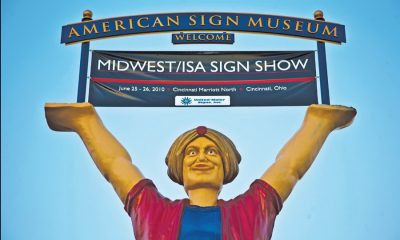Dimensional Signs
The Big Kahuna
Published
15 years agoon
It’s often been said about living in Hawaii, “When you’re there, you’re there.” Although it’s not likely to spawn a reality show (Tougher in Hawaii wouldn’t sell; who would sympathize with the residents of a tropical paradise?), the 2,000 miles that separate the Aloha State from the California coast often hinders obtaining key goods and services mainlanders take for granted. Therefore, this lack of proximity greatly inflates the cost of operating a business.
But, Hawaii’s charming, somewhat laconic pace and ideal weather provide undeniable appeal. They lured Illinois native Doug Allan there for an education, and, when he needed a professional jump-start, he returned. After years of building his own company, Island Sign, as a one-man operation, Allan has learned the benefits of delegation and the fine art of management. And, as Hawaii celebrates its 50th anniversary – the official milestone occurred on August 21 – and, coincidentally, he celebrates his 50th year, Allan looks forward to using traditional skills and a new business model to grow his business in the future.
Aloha (and aloha)
Simply put, Allan was born under a wandering star. After having graduated from high school in 1977, he briefly matriculated at Northern Illinois University, but soon succumbed to his wanderlust. Two years later, Allan settled near Eugene, OR, where he took a job to build custom, orthotic furniture for a hospital’s treatment facility for handicapped children. Then, Allan spent three years working a tree planter with a tree-planting cooperative. Although he enjoyed the freedom of working outdoors, Allan realized his work didn’t provide ideal long-term career prospects.
“I was living a carefree life, but I was getting to the age where I realized I need some career direction,” he said. “I’d always had an interest in math and art, so architecture seemed like a logical course of study.”
He moved to Hawaii in 1984 to study architecture at the University of Hawaii at Hilo, which served the dual purpose of also fulfilling Allan’s dream to enjoy what he called “America’s final frontier.” After having earned an associate’s degree in architectural drafting there, he worked itinerantly as a draftsman.
AdvertisementIn 1989, Allan decided to visit the East Coast and hitchhiked his way to NYC. With only $100 in his pocket, a friend’s phone number and a plane ticket home, Allan had reached a crossroads. Fortuitously, he found work at an ASI Sign Systems branch in the Big Apple. Allan began as an order-entry specialist, but the shop’s manager soon realized he was overqualified and began training him to operate graphics software. Soon, he helped institute changes that streamlined how ASI fabricated fire-evacuation map signage.
After a year at ASI, he migrated to New Mexico to be near his daughter and her mother. A print and copy shop hired him for production work fabricating cut-vinyl, flat signage, window graphics, banners and vinyl-clad faces for internally illuminated sign cabinets.
From there, Allan moved on to an engraving and screenprinting shop. Work for the Intel Corp.’s processor-chip manufacturing facility nearby comprised most of his work. Allan’s architectural background provided him experience with coordinating installations, developing blueprints and creating bid packages.
However, Allan craved a return to the 50th state and, in 1995, he went to work for Island Sign, which was then primarily a screenprinting outfit. At that time, decorating surfboards, which entailed using rice paper to screenprint graphics onto the board – which embeds ink just below the surface – represented most of the shop’s workload.
On his own
Although his early work with Island Sign was relatively simple and profitable, Allan envisioned a broader spectrum of work for the shop. Living very frugally on his fabricator’s wages (he also worked for a complementary signshop that shared the building), he saved enough money to buy Island Sign in 1997. It was a high-risk, high-reward move.
Advertisement“After buying the shop, I had hardly anything to my name,” Allan said. “But, I was very intent on creating a full-service sign company. I was able to locate a used copy of CASMate [software] and a well-worn |2323| PNC 1050 plotter.”
Initially, he worked with a local wholesaler to produce the bulk of his digital graphics. But, as Allan became more familiar with the technology, he bought a Gerber EDGE and brought the work inhouse. Allan said, “Next to buying the business, that $25,000 investment was the scariest I’ve ever made.”
As both markets grew for Island Signs, his equipment lineup grew. Today, he operates a Mimaki JV-3 solvent-ink printer as well as his seasoned Gerber EDGE and, to craft dimensional signage, he implements a MultiCam 3000 CNC router. He’s also streamlined his design process to include Adobe Photoshop and Illustrator and FlexiSign 8; to prep files for the router, he uses SA Intl.’s EnRoute 4. But, his design background usually helps make the sale.
“With a 10-minute pencil sketch, I can usually create a concept that’s refined enough to convey my idea and solicit customer feedback,” Allan said. “Then, I’ll refine my ideas with the program. To give the customer a sense of comparison, I’ll develop a couple of concepts in addition to what we’ve initially discussed.”
One of Allan’s favorite jobs entailed fabricated a 3-D building sign for Latitudes, a Maui furniture store. The sign comprises routed letters decorated with 23k goldleaf against a smalt background and a gilded border. He also crafted background panels from laminated-HDU slabs.
He credits the Letterhead movement with helping provide the resources and support to undertake such ambitious signage: “On the islands, I’ve never seen another sign with smalt, and very few with goldleaf. It was through developing relationships with Letterheads and attending meets that I gained the skill and confidence to attempt such a sign. Otherwise, I would have lost out on this $11,000 opportunity, and sold them the $2,000 sign they initially requested..”
AdvertisementBuilding a better mousetrap
As mentioned before, Hawaii’s lack of proximity to anywhere creates challenges for business owners. Allan said keeping proper inventory requires constant supervision.
“If I pay $6,000 for a pallet of supplies, at least $500 of that charge will be for the freight,” he said. “If I have to place a rush order on a specific item, odds are I’ll pay as much or more for the shipping as I will for the item itself. Too many instances like that will kill your profitability.”
Allan also realized enhancing customer-service and salesmanship would bolster the business. He found Michael Gerber’s book, The E-Myth, to be an insightful resource. Allan said, “The E-Myth reminds would-be entrepreneurs that, although an owner may have the technical skills to make a product, he will fail if customer service and relationship building aren’t a core component of the business.”
He made a calculated risk by hiring his first employee four years ago. Living in a place where tourism and construction constitute the two largest economic segments, Allan thought enlarging his shop and hiring staff would help Island Sign gain opportunities for more and better sign projects.
Today, he employs two full-time and two part-time staffers. His first employee, “Phat” Tony Johnson, returned to the fold and now helps manage the shop. Andy Olloff and Abbie Kimmel also play a key role in the shop’s production. Today, Allan happily works “on the business instead of in the business.”
“To me, that means finding ways to raise awareness of our business, making sales calls and spearheading marketing efforts,” he said. “Of course, I still help manage our shop’s production schedule and make any necessary tough decisions, but I’m very confident in the team I have in place.”
His marketing efforts have included embracing social media and other avenues. Allan regularly updates his website’s (www.islandsign.com) blog, which contains personal, shop and business-related articles and information. He’s also become actively involved with Twitter, Facebook and LinkedIn, which Allan said represent a somewhat counterintuitive marketing model.
“In the past, you tried to identify a target market before casting your net,” he said. “With social media, you often don’t know exactly whom you’re targeting. But, with so many potential opportunities out there, you have to use your available tools.”
Allan is also actively involved with the Maui Chamber of Commerce, for whom he hosted an in-shop event in June. And, in July, he was elected the first president of Signs101.com, an industry discussion forum. The group created the office in an attempt to create a form of self-governance for the site, Allan said.
The many aggressive changes he’s made constitute an effort to stay ahead of the curve. “Life in general, and technology in particular, tend to move very slowly in Hawaii,” Allan said. “A lot of people still just look in the Yellow Pages to find a company, although that’s slowly changing. It’s important to remain progressive and change with the times, yet still focus on your core talents and resources.”
Doug Allan, proprietor of Island Sign (Kahului, HI), purchased his shop in 1997. He gradually transformed it into to a full-service shop that offers digital graphics and 3-D signs. When a reckless truck driver demolished Allan’s old sign, he seized the opportunity and created a signature piece. After having framed the shape of the Hawaiian island chain as color blobs on a palette, input from Letterheads helped him perfect the design. Island Sign fabricated this CNC-routed sign with HDU bonded to Extira™ composite-wood backing. Smalt and 24k goldleaf add an air of elegance and accent the sign’s dimension. Allan successfully persuaded the owner of the Lightning Bolt surf shop that a multi-layered sign panel would add greater visual impact to his storefront. He added, “The investment paid for itself, and he’s very satisfied.”

SPONSORED VIDEO
Introducing the Sign Industry Podcast
The Sign Industry Podcast is a platform for every sign person out there — from the old-timers who bent neon and hand-lettered boats to those venturing into new technologies — we want to get their stories out for everyone to hear. Come join us and listen to stories, learn tricks or techniques, and get insights of what’s to come. We are the world’s second oldest profession. The folks who started the world’s oldest profession needed a sign.
You may like

American Sign Museum Names New Executive Director

3 Things Print Pros Must Do to Build Stronger Relationships in the Interiors Market

Graphics Turn an Eyesore Cooler Into a Showpiece Promo in Historic Plaza
Subscribe

Bulletins
Get the most important news and business ideas from Signs of the Times magazine's news bulletin.
Most Popular
-

 Tip Sheet1 week ago
Tip Sheet1 week agoAlways Brand Yourself and Wear Fewer Hats — Two of April’s Sign Tips
-

 Photo Gallery2 days ago
Photo Gallery2 days ago30 Snapshots of the 2024 ISA Sign Expo
-

 Ask Signs of the Times4 days ago
Ask Signs of the Times4 days agoWhy Are Signs from Canva so Overloaded and Similar?
-

 Real Deal1 week ago
Real Deal1 week agoA Woman Sign Company Owner Confronts a Sexist Wholesaler
-

 Benchmarks6 days ago
Benchmarks6 days ago6 Sports Venue Signs Deserving a Standing Ovation
-

 Editor's Note2 weeks ago
Editor's Note2 weeks agoWhy We Still Need the Women in Signs Award
-

 Women in Signs1 week ago
Women in Signs1 week ago2024 Women in Signs: Megan Bradley
-

 Photo Gallery1 week ago
Photo Gallery1 week ago21 Larry Albright Plasma Globes, Crackle Tubes and More









